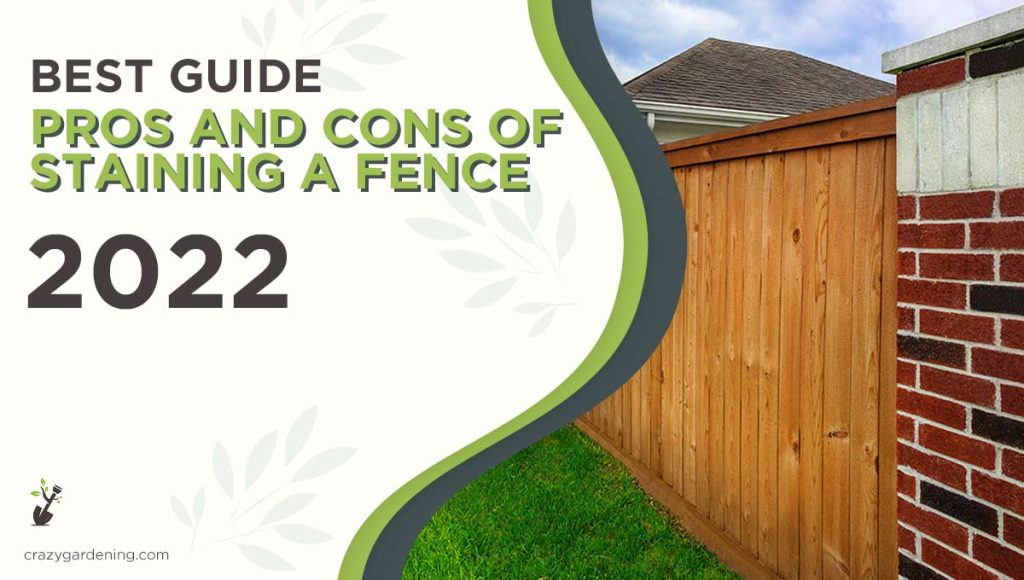Pros and Cons of Staining a Fence[Painting vs Staining 2025]
When it comes to staining a fence, there are many pros and cons to consider. On the one hand, staining can protect your fence from the elements and make it last longer.
On the other hand, staining can be expensive and time-consuming, and it might not be necessary if your fence is in good condition.
Other than staining, you can also hide your ugly fence in a great way.
In this blog post, we’ll discuss the pros and cons of staining a fence so that you can make an informed decision about whether or not to do it. Stay tuned!

What Is Meant By “Staining a Fence”?
Staining a fence refers to the process of applying a colored coating to the fence in order to protect it from the elements and extend its lifespan.
This can be done with either a water-based or oil-based stain, and there are many different colors to choose from.
The Pros and Cons of Staining a Fence
Pros
Attractive
A stained fence can be very attractive, and it can add to the curb appeal of your home. This attraction factor can also add to the resale value of your property.
Protection
The main purpose of staining a fence is to protect it from the elements. This is especially important if you have a wood fence, as it will help to prevent the wood from rotting or decaying.
Extended Lifespan
A stained fence will last longer than an unstained fence. This is because the stain acts as a barrier against the elements, and it can also help to repair any existing damage to the fence.
Cons
Expensive
Staining a fence can be quite expensive, especially if you hire a professional to do it.
Time-consuming
Staining a fence is a time-consuming process, and it will need to be repeated every few years in order to maintain its protection.
Not Necessary
If your fence is in good condition and you don’t live in an area with harsh weather conditions, then staining your fence might not be necessary.
How to Decide if You Should Stain Your Fence?
Now that you know the pros and cons of staining a fence, you might be wondering how to decide if it’s right for you.
The answer will depend on a few factors, such as the condition of your fence, the climate you live in, and your budget.
Fence Condition
If your fence is in good condition and you don’t live in an area with harsh weather conditions, then staining your fence might not be necessary.
However, if your fence is starting to show signs of wear and tear, or if it’s made of softwood that is susceptible to rot, then staining it would be a good idea.
Climate Conditions
If you live in an area with harsh weather conditions, such as high winds, rain, or snow, then staining your fence is a good way to protect it from the elements.
Budget
Staining a fence can be expensive, so you’ll need to consider your budget when making your decision. If you’re on a tight budget, you might want to wait until your fence needs repair before you stain it.
Painting vs Staining: What’s the Difference?
Painting and staining are two popular methods for changing the color and appearance of surfaces like wood, concrete, and metal.
The primary difference between painting and staining is the way they change the surface’s appearance.
Painting involves applying a coat of paint to the surface, which creates an opaque finish that covers the surface entirely.
Paint can be applied in a wide range of colors and finishes, from matte to glossy. Painting is ideal for surfaces that require a solid, uniform appearance, like walls, cabinets, and furniture.
On the other hand, staining involves applying a thin layer of stain to the surface, which penetrates the surface’s pores and enhances the natural color and grain of the material.
!
Stains are available in a variety of colors and finishes, from light to dark and matte to glossy. Staining is ideal for surfaces like wood, where you want to highlight the natural beauty of the material.
In addition to appearance, there are other differences between painting and staining. Painting provides a layer of protection to the surface, shielding it from damage due to weather, UV light, and wear and tear.
Staining, on the other hand, does not provide as much protection and may require regular reapplication.
Another difference is the application process.
Painting usually requires several coats and often requires priming and sanding before painting. Staining, on the other hand, requires a single coat, and no sanding or priming is necessary.
Overall, the choice between painting and staining depends on the surface’s material, your desired appearance, and your maintenance preferences.
How can I Stain my Fence?
If you’ve decided that staining your fence is the right choice for you, then you’ll need to know how to do it.
Select Stain
The first step is to choose the right type of stain for your fence. If you have a wood fence, you can use either a water-based or oil-based stain. If you have a metal fence, you’ll need to use an oil-based stain.
Prepare the Fence
Once you’ve selected your stain, you’ll need to prepare the fence for staining. This includes cleaning the fence, sanding it down, and removing any rust.
You’ll also need to make sure that the fence is dry before you begin staining.
Apply the Stain
Now it’s time to apply the stain. If you’re using a brush, start at the top of the fence and work your way down.
If you’re using a roller, start in the middle of the fence and work your way out. Once you’ve finished staining the fence, you’ll need to let it dry.
Staining a fence is a time-consuming process, but it’s well worth it in the end. A stained fence will last longer than an unstained fence, and it can also add to the curb appeal of your home.
Conclusion
Staining a fence has both pros and cons that you’ll need to consider before making a decision.
If your fence is in good condition and you don’t live in an area with harsh weather conditions, then staining your fence might not be necessary.
However, if your fence is starting to show signs of wear and tear or if it’s made of softwood that is susceptible to rot, then staining it would be a good idea.
If you’re on a tight budget, you might want to wait until your fence needs repair before you stain it.
FAQs
Question
How much longer will a fence last with stain?
Answer
Staining a fence can significantly extend its lifespan by protecting it from the elements, including UV rays, moisture, and insects, potentially adding several years to its life.
Question
Can I Stain My Fence Myself?
Answer
Yes, you can. However, it’s important to note that staining a fence is a time-consuming process, and it will need to be repeated every few years in order to maintain its protection.
Question
What’s the Difference Between a Water-Based Stain and an Oil-Based Stain?
Answer
Water-based stains are easier to apply and clean up, but they don’t last as long as oil-based stains. Oil-based stains are more difficult to apply and clean up, but they provide better protection for your fence.
Question
Is staining your fence worth it?
Answer
Staining is a great option for increasing your fence’s lifespan and keeping it beautiful. It’s an investment that will pay off in the long run.
Question
How often should I stain my fence?
Answer
It depends on the type of stain you’re using and the climate conditions in your area. Generally, water-based stains need to be reapplied every one to three years, while oil-based stains can last for up to five years.
Question
How do I remove stains from my fence?
Answer
The best way to remove stains from your fence is to hire a professional. If you’re attempting to do it yourself, you’ll need to use a power washer or a sandblaster.
Question
What happens if you don’t stain a fence?
Answer
If you don’t stain a fence, it will be susceptible to weathering, rot, decay, and insect damage, which can reduce its lifespan and compromise its structural integrity.


